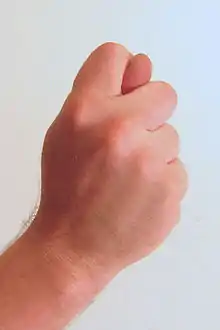Fig sign
The fig sign is a mildly obscene gesture that uses a thumb wedged in between two fingers. The gesture is most commonly used to ward off the evil eye, insult someone, or deny a request. It has been used at least since the Roman Age in Southern Europe and parts of the Mediterranean region, including in Turkish culture. Some countries in Asia, Slavic cultures and South Africa use it too. It is used playfully in Northwestern Europe and countries such as the US, Canada, Australia, and Czech Republic to pretend to take the nose off a child.

The letter "T" in the American manual alphabet is very similar to this gesture.
The hand gesture may have originated in ancient Indian culture to depict the lingam and yoni.[1]
Historical usage
Among early Christians, it was known as the manus obscena, or 'obscene hand'.[1]
In ancient Rome, the fig sign, or manu fica, was made by the pater familias to ward off the evil spirits of the dead as a part of the Lemuria ritual.[2][3]
The ancient Greeks wore amulets of the gesture around the neck to protect from the evil eye, and also used the gesture in artwork. What they considered an overtly sexual gesture was expected to distract evil spirits from causing harm.[4]
The word sycophant comes from the Ancient Greek word συκοφάντης (sykophántēs), meaning "one who shows or reveals figs"; though there is no unequivocal explanation as to the reason why sycophants in Ancient Greece were so called, one explanation is that the sycophant, by making false accusations, insulted the defendant in a manner analogous to making the fig sign.[5]
In Italy this sign, known as fica in mano ('fig-hand'), or far le fiche ('to make the fig'), was a common and very rude gesture in past centuries, similar to the finger, but has long since fallen out of use.[1] Notably, a remnant of its usage is found in Dante's Divine Comedy (Inferno, Canto XXV), and it is commonly represented in medieval paintings of the Man of Sorrow. The same gesture is now used, as a joke, with children, but represents the stealing of the nose and has no offensive or sexual meaning.
International nomenclature

Derogatory
- In Greece and particularly in the Ionian Islands this gesture is still used as an alternative to the moutza. It is known as a "fist-phallus", and can be accompanied by extending the right hand while clasping the left hand under one's armpit in a derogatory manner.[1]
- In Carinthia it’s used to derisively dismiss the size of a man’s genitalia.
- In South Africa, it was once known as "the zap sign" and was the equivalent of giving the finger. The sign is nowadays known as the "toffee sign", particularly in Afrikaans culture.
- In Madagascar, the gesture is an insult referring to one's mother's genitalia.
- In Romania and Moldova the gesture is an insult often referring to "Hai sictir" which means "shut up" or "fuck off."
- In Mongolia, the gesture is called "salaavch" (Mongolian: Салаавч) and means "between the gap". Oftentimes one would say "mai!" (Mongolian: май!) meaning something along the line of "get this" or "here you go." Sometimes one could spit at the fig shape before showing it. It is to imitate the shape of female genital to insult others.
.jpg.webp)
Sexual
- In Indonesia and the Netherlands, it is a gesture symbol for sexual intercourse. Where the thumb represent the male genitalia, the middle and index finger act as the female genitalia, this is to replicate the penetration of the male genitalia into the female genitalia. This hand gesture is still popular especially among men.
- In Japan this sign is called セックス (sekkusu) and means sex.[6]
- In Belgium, Denmark and Germany the gesture is used as an invitation to sex.[4]
As disagreement or dismissal
- In Armenia, when someone asks you something and you don't feel like doing it or feel annoyed you respond with the Fig sign. It can also have a sexual meaning and can even be used as a way to say "Fuck You".
- In Russia it is rude and conveys refusal with a sense of absoluteness and finality. The expression fig tebe! ("fig to you!") is also used in place of the gesture.[7]
- In Poland it is used to express refusal to a request.[8]
- In Lithuania it's called špyga and usually when using it some would say špyga taukuota. As in Russia and Poland it means denying a request and refusing to do it. It's not as commonly used now, but more by the generation born around 1950s–60s as well as their parents' generation.
- In Belarus, it is not considered an obscene gesture; it is rather used to express disagreement or denial in a rude form, but it doesn't have insulting or abusing someone as its main goal. Parents won't care much about their children using this gesture, unlike for the middle finger which is considered obscene.
- In Croatia, Serbia and Slovenia it is used when denying a request or when swearing a false oath. In the request denial case it is called a fig (figa) but also a "rose hip" (Šipak / Шипак). Evo ti figa/Šipak! (here is a fig/rose hip for you!) is a slightly rude but also a humorous way of rejecting someone's request. In addition — it is also used when swearing a false oath or falsifying an affirmation to tell the truth. In this case, it is said that a person is taking a false oath by hiding a fig sign in a pocket (figa u džepu).[9]
- In Turkey, it is an obscene gesture equivalent to showing the middle finger, and is also used to show disagreement at a statement or to deny a request. In the latter sense, it is often accompanied by the (rude) nah! conveying negation or disagreement (see wiktionary:nah), or by the imperative al! meaning 'take it!', or the combination of the two: nah alırsın! meaning 'you will get nothing!' Thus, the gesture is often referred to as nah çekmek, meaning to 'draw (show) a nah'. It is used in a similar context in Bulgaria and Ukraine.
- In Korea, it has a likewise meaning as in Turkey as to mean "Here have it!", often accompanied by a gesture in which one looks through his/her pockets as of searching something later to reveal the fig sign. It's an old sign and fallen into mostly disuse.
Other uses
- In many countries, such as the United Kingdom, Ireland, Canada, France, Spain, Czech Republic, Argentina, Uruguay, and the United States, this sign has no obscene meaning and is instead used in a game where a player "steals" someone else's nose. This is usually done with small children where the player pretends to take their nose and then say "I've got your nose". The thumb represents the "stolen" nose held between the player's index and middle finger. This innocent meaning may exist alongside the obscene one.[4]
- In Portugal, Galicia and in Brazil it is a gesture of good luck, or even wishing good luck. It is also believed to ward off evil eye and protect oneself from evil. In these countries, an amulet of a hand performing the Fig sign is worn as a good luck or protective charm.[4]
See also
- I've got your nose
- Apotropaic magic
- Mano Figa jewellery charm
References
- Hamilton, Terri (2007). Skin Flutes & Velvet Gloves. p. 279–80. ISBN 9781429974790.
- Adkins, Lesley (2004). Handbook to Life in Ancient Rome. p. 317.
- Ovid. Fasti. 5.429-443.
- Armstrong, Nancy; Wagner, Melissa (2015-05-19). Field Guide to Gestures: How to Identify and Interpret Virtually Every Gesture Known to Man. Quirk Books. ISBN 978-1-59474-849-3.
- Hugh, Chisolm, ed. (1911). "Sycophant". Encyclopædia Britannica. Vol. 26 (11th ed.). p. 276–77.
According to C. Sittl (Die Gebdrden der Griechen und Romer, Leipzig, 1890) the word refers to an obscene gesture of phallic significance (see also A. B. Cook in Classical Review, August 1907), called "showing the fig" (faire la figue, far la fica or le fiche), originally prophylactic in character. Such gesture, directed towards an inoffensive person, became an insult, and the word sycophant might imply one who insulted another by bringing a frivolous or malicious accusation against him.
- Hamiru-aqui (2008). 70 Japanese Gestures. Translated by Aileen Chang. Stone Bridge Press. pp. 98–99. ISBN 978-1933330013. Retrieved June 19, 2013.
- "The world of Russian folk gestures". Russia Beyond.
- "ktoś pokazał figę". WSJP.
- "Što znači... Figa u džepu" - in Croatian